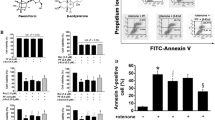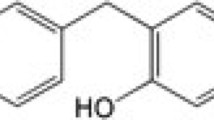Abstract
Rotenone is an inhibitor of mitochondrial complex I-induced neurotoxicity in PC12 cells and has been widely studied to elucidate the pathogenesis of Parkinson’s disease. We investigated the neuroprotective effects of betaine on rotenone-induced neurotoxicity in PC12 cells. Betaine inhibited rotenone-induced apoptosis in a dose-dependent manner, with cell viability increasing from 50 % with rotenone treatment alone to 71 % with rotenone plus 100-μM betaine treatment. Flow cytometric analysis demonstrated cell death in the rotenone-treated cells to be over 50 %; the number of live cells increased with betaine pretreatment. Betaine pretreatment of PC12 cells attenuated rotenone-mediated mitochondrial dysfunction, including nuclear fragmentation, ATP depletion, mitochondrial membrane depolarization, caspase-3/7 activation, and reactive oxygen species production. Western blots demonstrated activation of caspase-3 and caspase-9, and their increased expression levels in rotenone-treated cells; betaine decreased caspase-3 and caspase-9 expression levels and suppressed their activation. Together, these results suggest that betaine may serve as a neuroprotective agent in the treatment of neurodegenerative diseases.







Similar content being viewed by others
References
Batandier C, Fontaine E, Keriel C, Leverve XM (2002) Determination of mitochondrial reactive oxygen species: methodological aspects. J Cell Mol Med 6:175–187
Bidulescu A, Chambless LE, Siega-Riz AM, Zeisel SH, Heiss G (2007) Usual choline and betaine dietary intake and incident coronary heart disease: the Atherosclerosis Risk in Communities (ARIC) study. BMC Cardiovasc Disord 7:20
Caserta MT, Bannon Y, Fernandez F, Giunta B, Schoenberg MR, Tan J (2009) Chapter 1 Normal brain aging: clinical, immunological, neuropsychological, and neuroimaging features. Int Rev Neurobiol 84:1–19
Cave M, Deaciuc I, Mendez C, Song Z, Joshi-Barve S, Barve S, McClain C (2007) Nonalcoholic fatty liver disease: predisposing factors and the role of nutrition. J Nutr Biochem 18:184–195
Craig SA (2004) Betaine in human nutrition. Am J Clin Nutr 80:539–549
Dauer W, Przedborski S (2003) Parkinson’s disease: mechanisms and models. Neuron 39:889–909
Du YP, Peng JS, Sun A, Tang ZH, Ling WH, Zhu HL (2009) Assessment of the effect of betaine on p16 and c-myc DNA methylation and mRNA expression in a chemical induced rat liver cancer model. BMC Cancer 9:261
Fukae J, Mizuno Y, Hattori N (2007) Mitochondrial dysfunction in Parkinson’s disease. Mitochondrion 7:58–62
Ganesan B, Anandan R (2009) Protective effect of betaine on changes in the levels of lysosomal enzyme activities in heart tissue in isoprenaline-induced myocardial infarction in Wistar rats. Cell Stress Chaperones 14:661–667
Ganesan B, Anandan R, Lakshmanan PT (2011) Studies on the protective effects of betaine against oxidative damage during experimentally induced restraint stress in Wistar albino rats. Cell Stress Chaperones 16:641–652
Ho YS, So KF, Chang RC (2010) Anti-aging herbal medicine–how and why can they be used in aging-associated neurodegenerative diseases? Ageing Res Rev 9:354–362
Kanbak G, Inal M, Baycu C (2001) Ethanol-induced hepatotoxicity and protective effect of betaine. Cell Biochem Funct 19:281–285
Keane PC, Kurzawa M, Blain PG, Morris CM (2011) Mitochondrial dysfunction in Parkinson’s disease. Parkinsons Dis 2011:716871
Kirkinezos IG, Moraes CT (2001) Reactive oxygen species and mitochondrial diseases. Semin Cell Dev Biol 12:449–457
Martin LJ (2010) Mitochondrial and cell death mechanisms in neurodegenerative diseases. Pharmaceuticals (Basel) 3:839–915
Mehler MF, Gokhan S (2000) Mechanisms underlying neural cell death in neurodegenerative diseases: alterations of a developmentally-mediated cellular rheostat. Trends Neurosci 23:599–605
Moran M, Rivera H, Sanchez-Arago M, Blazquez A, Merinero B, Ugalde C, Arenas J, Cuezva JM, Martin MA (2010) Mitochondrial bioenergetics and dynamics interplay in complex I-deficient fibroblasts. Biochim Biophys Acta 802:443–453
Pettmann B, Henderson CE (1998) Neuronal cell death. Neuron 20:633–647
Petty RD, Sutherland LA, Hunter EM, Cree IA (1995) Comparison of MTT and ATP based assays for the measurement of viable cell number. J Biolumin Chemilumin 10:29–34
Ribe EM, Serrano-Saiz E, Akpan N, Troy CM (2008) Mechanisms of neuronal death in disease: defining the models and the players. Biochem J 415:165–182
Riederer BM, Leuba G, Vernay A, Riederer IM (2011) The role of the ubiquitin proteasome system in Alzheimer’s disease. Exp Biol Med (Maywood) 236:268–276
Samantaray S, Knaryan VH, Guyton MK, Matzelle DD, Ray SK, Banik NL (2007) The parkinsonian neurotoxin rotenone activates calpain and caspase-3 leading to motoneuron degeneration in spinal cord of Lewis rats. Neuroscience 146:741–755
Shin YG, Cho KH, Kim JM, Park MK, Park JH (1999) Determination of betaine in Lycium chinense fruits by liquid chromatography-electrospray ionization mass spectrometry. J Chromatogr A 857:331–335
Tenenbaum L, Chtarto A, Lehtonen E, Blum D, Baekelandt V, Velu T, Brotchi J, Levivier M (2002) Neuroprotective gene therapy for Parkinson’s disease. Curr Gene Ther 2:451–483
Velier JJ, Ellison JA, Kikly KK, Spera PA, Barone FC, Feuerstein GZ (1999) Caspase-8 and caspase-3 are expressed by different populations of cortical neurons undergoing delayed cell death after focal stroke in the rat. J Neurosci 19:5932–5941
Vila M, Ramonet D, Perier C (2008) Mitochondrial alterations in Parkinson’s disease: new clues. J Neurochem 107:317–328
Wei HL, Jiafeng S, Ming C, Hongyan C, Linsen H (2008) Mechanisms of rotenone-induced neurotoxicity in PC 12 cells. Neural Regen Res 3:1281–1285
Weir HJ, Murray TK, Kehoe PG, Love S, Verdin EM, O’Neill MJ, Lane JD, Balthasar N (2012) CNS SIRT3 expression is altered by reactive oxygen species and in Alzheimer’s disease. PLoS One 7:e48225
Acknowledgments
This research was supported by the “Study of aging-control by energy metabolism based on oriental medicine (K12101)” funded by the “KM-Based Herbal Drug Research Group” of the Korea Institute of Oriental Medicine.
Author information
Authors and Affiliations
Corresponding author
Rights and permissions
About this article
Cite this article
Im, AR., Kim, YH., Uddin, M.R. et al. Betaine Protects Against Rotenone-Induced Neurotoxicity in PC12 Cells. Cell Mol Neurobiol 33, 625–635 (2013). https://doi.org/10.1007/s10571-013-9921-z
Received:
Accepted:
Published:
Issue Date:
DOI: https://doi.org/10.1007/s10571-013-9921-z




